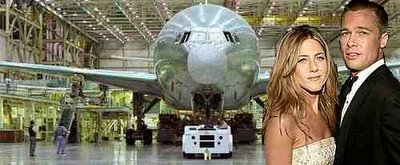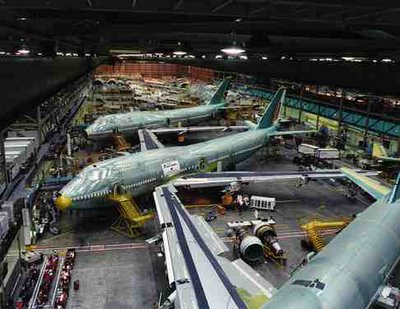
(How the hell else am I going to get my non-pilot reader(s) to read this post?)
One of my activities when out in Seattle was to take a tour of Boeing's Everett assembly plant. I've taken this tour before, seven or eight years ago, but I could practically set up a chair in a corner and accept being paid to just watch for a living. This particular plant is responsible for wide-body production, and there are separate production lines for the 747, the 767 and the 777. And now they're about to start another production line in an unused part of the factory for the coming 787 "Dreamliner." (There is another plant for production of narrow-body planes, currently only the 737 after the demise of the 757 line in October of 2003, a few miles away in Renton, WA.)
I honestly think that non-pilots, and likely even non-technophiles would find this tour intriguing (without my wife's testimony I cannot offer actual technophobe reaction). It takes the tour and a bit of contemplation to get one's head around the scope of what this plant actually does. OK, they make airplanes; big deal. But each 767 (the smallest of the three current widebodies) will set you back a cool $155 million, and a majority of that money goes toward stuff people do not anticipate, toward solutions to problems unfathomed.
I've blathered on before about how complicated a modern airplane is, but to see them taking shape from some six million separate parts is to grasp this to a degree previously unimagined. You can look down the line and see five or six gigantic airplanes in varying stages of doneness, from one directly beneath our viewing stand that's nearly ready to fly, to a collection of parts in the far distance which require a feat of imagination to see the airplane to come. And this is one of three functioning production lines running simultaneously under a single roof (not incidentally, the largest enclosed space on earth). This industry now, with our teetering auto industry in decline, represents the acme of engineering might and design power in our culture, and a tour of the plant lays this truth at one's feat quite clearly.

But beneath this there is a perilous economic reality. The business of ideating and producing a new jetliner is absolutely precarious for any company undertaking it. Since the 747 project (if not before), every new airplane that Boeing has undertaken has been a make-or-break proposition for the company. This latest venture, the 787, is no exception. Think of the pressure! The engineering resources on which the project rests are impossibly expensive, and nothing is simple. Mistakes are surely made, but there's a line beyond which errors are simply not allowable. The survival of the company rides on the viability of the concept and the quality of the resulting product, which must remain attractive and competitive for a couple decades if the company's bloodletting is to be rectified. (In spite of things touched on later, this tightrope is walked by Airbus as well.)
And even that threat doesn't get to the whole banana. Boeing is the Seattle area's largest employer, with some 50,000 local employees, and a worldwide total of 152,000. And that's just Boeing. Even with all that the company accomplishes at the Everett plant, a huge proportion of the airplane comes in from other plants and other suppliers. So the survival of Boeing ensures the nourishment of a wide network of industries. And it ensures the American presence in this very high-profile and high-tech field, a presence which circles the globe and announces itself prominently in every country and on every continent. The death of Boeing would be a staggering blow to our country. And maybe even that understates it.
There is an ongoing battle between Airbus and Boeing, both over market share (which swung to Airbus a few years ago for the first time in history, but which I believe Boeing regained for 2005 [later, I've learned that Airbus just squeaked by Boeing for 2005]) and, more importantly, over government subsidizing. Airbus is a consortium of European companies--French, German, Spanish and British--each of which receives (as I understand it) a subsidy from its national government. This has enabled Airbus traditionally to charge a lower price for its airplanes than the market would bear, or, more saliently, lower than what Boeing can afford to charge. It is said that this pricing strategy has played a huge role in Airbus's rise to dominance. Airbus retorts that our military branches give preference to Boeing, often awarding contracts non-competitively.
Whatever the bottom line, this is serious business. One by one, we have seen the companies who undertake this near-impossible task beaten out of the industry. Rockwell, Lockheed, Douglas, to name a few (the former two still do military work, I believe). And it is in this light we must view Airbus's decision to build the mammoth A-380, and contrast it to Boeing's decision to pursue a philosophically different tack with its 787. These are not airplanes which compete with one another, but it's a serious question whether they can both succeed; and the success of one may prove the other to have been a bad--and possibly fatal--decision. Airbus is banking on hub-to-hub operations, and on the very long range of the 380 to connect points which previously required a layover and / or a plane change. Boeing is counting on more people avoiding hubs and flying point-to-point, and it's focusing on improving the 787's efficiency by 20% over the 767. That's a lot.
I leave the experience with a flabbergasted appreciation of this industry that performs magic. It's like a chess board with 10,000 pieces, and with dire consequences for the loser (if indeed there must be one).
5 comments:
What's the deal on the new very little planes? I think that's what they are called (micro machines was already taken)
Is this a viable market, or just a gimmick?
I think they intend to be executive per-like travel for the pseudo-executive. They're still damn expensive from a real person perspective, tho. I'm not really sure if this is answering a real need or not; but surely companies like Honda will leave their mark. They will change things.
First of all, I really, really like Seattle! If I moved from the NYC area I would move to Seattle.
Second, I understand that Boeing wants to take over some building that's part of the SEA-TAC airport and if they don't get it they're threatening to leave? Do I have those details correct? What happened with that?
Third, as a non-airplane buff, I would still enjoy the tour. Ever been to the Mystic Seaport Museum? I'm not a boating or sailing buff and it's fantastic!
Nice post. Really I did read it. ;-) That's the consequence of studying Industrial Management, I am still fascinated by the process of manufacturing. Now when these planes are lined up, do they move from plane to plane like an assembly line or are there different teams working on each plane?
Brianalt--I'm with you! I LOVE the Seattle area. It has everything: mountains, forests, enough population to keep amenities close at hand, and, especially, water. I'd love to buy a 50' sailboat to live on in a marina there. Alas, I'll have to be content to visit.
I haven't heard of the Boeing / SeaTac tussle. But given the almost unfathomable expense of their setting up shop somewhere else, I can' t imagine they would make good on that threat. Still, I don't know shit about it.
I've not been to the seaport museum, but I would love it (being a sailing enthusiast). I'll have to look it up next time I'm in town (or send my brother to scope it out for me).
Kate--you get a gold star for actually reading the whole thing! As to your question, they do it a couple different ways. The Renton (narrowbody) plant is actually on a very slowly-moving assembly line, like a car plant. But the Everett plant has these "stations" where a range of things are completed before the airframe is moved onto the next station. It's this jigsaw complexity that makes the manufacture so fascinating. You can't put in such and such in the interior until THESE things are done to the interior of the structure, but they can't be done before this and this, etc. etc. So everything interrelates and interlocks in an almost impossibly complicated way. To look up at the unseen interior parts of the machine, where the "internals" are, you can see literally hundreds of cables and thousands of wires, scads of hydraulic lines and actuators, etc. Amazing. Nothing is there frivolously.
Post a Comment